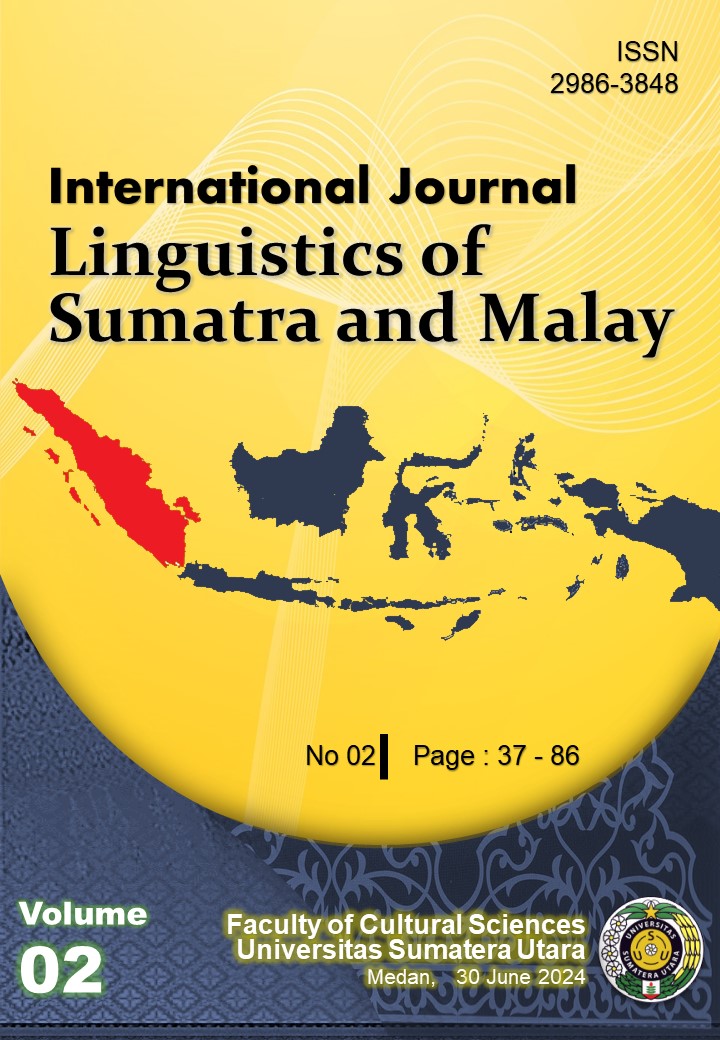Contrastive Causative Construction in Japanese and Indonesian: X-Bar Theory
DOI:
https://doi.org/10.32734/ijlsm.v2i2.15382Keywords:
Causative, Transitive, Intransitive, o/ni-saseru, Japanese and IndonesiaAbstract
This study aims to describe causative contractions in Japanese and Indonesian; how causative sentence structures in the form of diagrams through X-Bar theory, their meanings in Japanese and Indonesian, as well as their similarities and differences in both languages. The study used contrastive analysis to compare the causal sentence contraction of both languages. Research results show that the causal sentence construction of both languages is derived from non-causative sentences by converting predicates into causative verbs. However, there are several verbs in both Indonesian and Japanese, which already have a causative meaning, such as korosu (killing), akeru (opening), mawasu (spinning), and others. The causative construction of the Indonesian language is composed of three types: lexical causative, morphological causative, and paraphrastically causative. Japanese causative construction is only in lexical causative, and paraphrastically causative. The causative Japanese sentences are marked by the pronunciation of o-saseru and ni-saseru in intransitive verbs and transitive verbs at the end of the sentence. Also, ni and o-saseru appear in the same sentence as transitive verbs. Causative sentences of Indonesian can be formed by affixing ikan, -i, per-. The basic structure of Indonesian causative sentences is formed from inflections, spacer and verb phrases. The initial structure, predominantly FI over FV then, moved to the [Ses FP] position in its derivative structure.
Downloads
References
Blanco, M. (2011). Causative in Minimalism. Amsterdam: John Benjamins Publishing.
Comrie, B. (1981). Language Universals and Lingistics Typology. Oxford: Basil Blackwell.
Fukada, A. (2009). The Japanese Causative Controversy: A Pragmatic Perspective: Japanese Language and Literature. (2010). 44(1).
Goddard, C. (1998). Semantic Analysis-A Practical Introduction. Oxford: Oxford University.
Haegemen, L. (1994). Introduction to Government and Binding Theory. Malden: Blackwell
Hasibuan, Ibnu dan Mulyadi. (2019). Konstruksi Kausatif dalam Bahasa Mandailing: Kajian Tipologi Sintaksis: NUSA. (2019).14.(3)
Haspelmath, M. (2016). Universal of Causative and Anticausative Verb Formation and The Spontaniety Scale. Lingua Posnaniensies, LVIII (2)
Katada F. (2000). The Structure of Humble Causatives in Japanese: Linguistica Atlantica. (2000). 22
Kawaguchi, S. (2009). Acquiring causative constructions in Japanese as a second language: Japanese Studies. (2009). 29(2).
Kridalaksana, H. (2009). Kamus Linguistik. Jakarta: Gramedia
Lyons, J. (1995). Pengantar Linguistik Umum (Terjemah Bebas). Jakarta: PT Gramedia Pustaka Utama
Manning, C (2010). Studies in Contemporary Phrase Structure Grammar.
Mulyadi. (2004). Konstruksi Kausatif dalam Bahasa Indonesia. Linguistika, vol 11, 2004.
Narrog, H. (2004). From transitive to causative in Japanese: Diachrohnica. (2004). 21(2).
Neeleman, Ad and Koot, Hans. (2012). The Theta System: Argument Structure at the Interface: The Linguistic Expression of Causation. Oxford University Press: London.
Payne, T. (1997). Describing Morphosyntax: A Guide for Field Linguistics. Cambridge: Cambridge University Press.
Pylkkanen, L. (2008). Introducing Arguments. Cambridge MA: The MIT Press.
Sahara, Rita. Konstruksi Pasif Bahasa Jepang: Kajian Gramatikal Relasional: Soshum Jurnal Sosial Dan Humaniora, (2013). 3.(2)
Sari, S dan Mulyadi. (2018). Struktur Kalimat Kausatif dalam Bahasa Aceh Singkil: Analisis Teori X-Bar: Medan Makna. (2019).XVI.(2)
Shibatani, M. (1982). Japanese Grammar and Universal Grammar. Lingua 57 (p. 103-123). North Holland Publishing.
Shibatani, M. (1976). The Grammar of Causative Construction: A Conspectus. Shibatani (Ed.). Syntax and Semantic, 6:1-40. New York: Academic Press.
Takami, Kenichi. 2011. Ukemi to shieki: Sono Imi Kisoku o Sageru. Kitakusaha: Tokyo
Downloads
Published
Issue
Section
License
Copyright (c) 2024 International Journal Linguistics of Sumatra and Malay

This work is licensed under a Creative Commons Attribution-ShareAlike 4.0 International License.
All articles published in the International Journal Linguistics of Sumatra and Malay (IJLSM) are licensed under the Creative Commons Attribution-ShareAlike 4.0 International License (CC BY-SA 4.0).
This license permits anyone to:
-
Share — copy and redistribute the material in any medium or format.
-
Adapt — remix, transform, and build upon the material for any purpose, even commercially.









